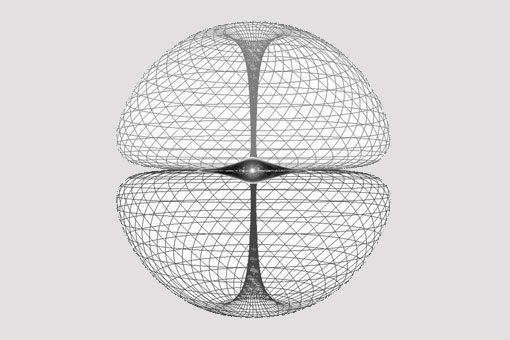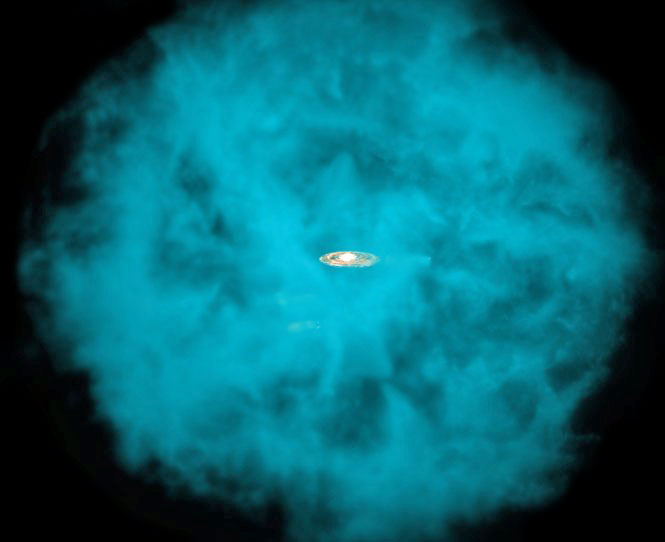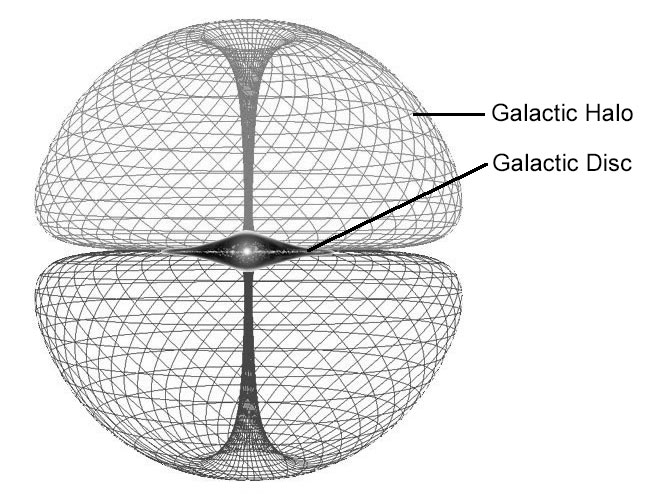Dual-Torus Galactic Geometry
This article outlines a theory that explains the “galactic rotation problem” – the fact that galaxies rotate faster than expected based on the mass we can see – without the need for theoretical and highly elusive “dark matter”.
The Dual-Torus Galactic Geometry theory proposes that galactic rotation is driven by a dynamically flowing energy fields with the geometry of a dual-torus.
Dual-torus geometry accounts for the formation of a flat galactic disc with spiral arms, the observed galactic rotation velocities and the spherical galactic halo.

Introduction
The planets rotate around the sun as conventional physics would predict, i.e. the closer they are to the centre of the solar system (the sun) the faster they move: Mercury 48 km/s, Venus 35 km/s, Earth 30 km/s, Mars, 24 km/s, Jupiter 13 km/s, Saturn, 10 km/s, Uranus 7 km/s and Neptune 5 km/s. Galaxies, on the other hand, do not rotate as conventional physics would predict because the outermost stars have roughly the same velocity as the inner stars, as shown in the graph below:

The density of luminous/visible matter decreases from the galactic centre to the outskirts. If this luminous/visible matter was the only matter that was present, Kepler’s Second Law predicts that rotation velocities should decrease as distance from the centre increases (as per the blue line on the graph), but this isn’t what actually occurs. The actual rotation velocities of most galaxies remain relatively constant as distance from the centre increases (as per the red line on the graph). So Kepler’s Second Law can correctly describe the velocities of planets orbiting the sun, but it fails to describe the velocities of stars orbiting galaxies. This means that something is clearly different at the galactic scale compared to the solar scale.
Dark Matter
Scientists generally explain this major discrepancy between the two lines of the graph by theorising the presence of large quantities of “dark matter” (non-luminous matter) in the vast galactic halo.
The galactic halo is a massive, near-spherical area of dispersed stars and gas surrounding the galactic disc. The halo of our Milky Way galaxy is known to extend at least 300,000 light-years from the centre, as depicted below, and its mass is several times greater than that of the visible galactic disc.

It has been estimated that approximately 85% of the matter in the universe is dark matter, yet after decades of searching, it has never once been discovered. And it doesn’t make sense that dark matter could influence the rotation of galaxies but not the orbit of planets, which are themselves inside galaxies.
An Alternative to Dark Matter?
It seems to me that galactic rotation isn’t a problem that can be “solved” (or fudged) by the creation of theoretical and elusive dark matter. Dark matter was only an idea in the first place, and it has never been discovered, so perhaps it’s time to actively consider that dark matter may have been a scientific wrong turn?
If we rule out hidden matter as an explanation for galactic rotation, then what other possibilities are there? Well, the previous article The Toroidal Universe described toroidal geometry in relation to the universe, so let’s reconsider toroidal geometry in relation to galaxies.
Spiral Galaxies
You only need to look at an image of a spiral galaxy (below) to see that it is a flattened vortex, like a whirlpool or a hurricane. A torus has a vortex running through its centre, so there could be something in this toroidal geometry idea.

The central axis of a torus is a rotating vortex, and the outer surface of a torus also rotates. But there may not be enough rotational “pressure” within the hollow body of a torus to account for the observed galactic rotation, so the torus theory may need to be modified slightly. And we also need to consider how toroidal geometry would result in the formation of a flat galactic disc with spiral arms.
Dual-Torus Galactic Geometry
Both of the above issues can be addressed with one simple modification to the torus theory, and that is changing it to a dual-torus theory – see below.

The dual-torus theory accounts for all of the following aspects of a galaxy’s form and flow:
- The outer surface of the dual-torus contains the galactic halo.
- The majority of the stars, etc. are contained between the two hemispheres of the dual-torus to create and maintain the flat galactic disc.
- The spiral motion of the two rotating hemispheres causes the galactic disc to rotate in a way that corresponds with observed galactic rotation.
- Slight variations in the currents of each hemisphere create ripples in the fabric of space-time between the hemispheres that contains the galactic disc, which accounts for:
- The undulating orbit of stars around the galaxy (below left).
- The formation of spiral arms, like ripples on a pond (below right).
So, all of the main aspects of galactic rotation can be described by the Dual-Torus Galactic Geometry theory.


Galactic Clocks
Astronomers at the International Centre for Radio Astronomy Research (ICRAR) have discovered that all galaxies, from small dwarf galaxies to the largest spiral galaxies, rotate once every billion years or so.
This common rate of rotation means galactic rotation is not driven by (or regulated by) size, mass or random forces. All galaxies clearly share some common factor that current scientific understanding cannot explain. I believe that common factor could be the dual-torus energy flow.
The ICRAR team have also shown that all galaxies of the same size have the same average interior density. Again, this consistency suggests a common factor that dual-torus geometry could explain.
To me, the ICRAR paper suggests that galaxies don’t just form according to gravitational forces, but according to an energetic template that probably has the geometry of a dual torus (or perhaps a single torus for dwarf galaxies).
